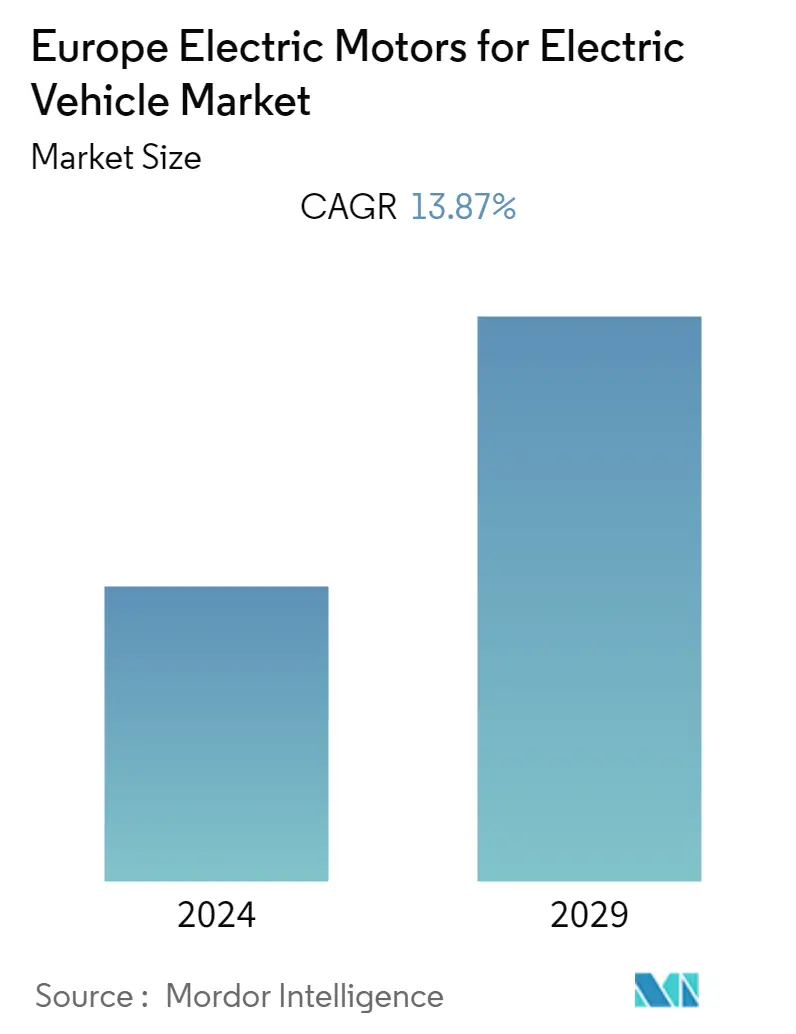Market Size of Europe Electric Motors for Electric Vehicle Industry

| Study Period | 2019 - 2029 |
| Base Year For Estimation | 2023 |
| Forecast Data Period | 2024 - 2029 |
| Historical Data Period | 2019 - 2022 |
| CAGR | 13.87 % |
| Market Concentration | Medium |
Major Players
*Disclaimer: Major Players sorted in no particular order |
Europe EV Electric Motors Market Analysis
The European electric motors for the electric vehicle market are valued at USD 126.85 billion in 2021 and are expected to surpass a net valuation of USD 276.53 billion by 2027 end, registering a solid CAGR growth of 13.87% over the forecast period.
Electric vehicles are witnessing significant growth owing to the need for addressing future energy requirements. The need to attain sustainable transportation plays a significant role in driving electric vehicle demand. Electric vehicles are coming up as an integral part of the automotive industry and represent a pathway towards achieving energy efficiency along with reduced emissions of pollutants and other greenhouse gasses.
Electric motors are the main component in the powertrain of any electric vehicle since the competition in electric vehicles is getting intense between the vehicle manufacturers, the conventional vehicle manufacturers are jumping into the electric vehicles market to attain an added advantage over competitors.
Although, during COVID-19 the market witnessed a steady decline amid the supply chain challenges faced by distributors and suppliers in Europe. In addition, the impact of COVID-19 on the electric vehicle market was inevitable as it affected almost every other industry in the market. However, the electric vehicle (EVs) market is witnessing substantial growth owing to the swiftly escalating year-on-year adoption rate of mild-hybrid electric vehicles across Europe. Soon after Q1 2022, demand for electric vehicles elevated the adoption of electric motors in Europe which has taken the market again to the recovery phase. For instance, In Q1, 2022 Volkswagen Group which includes Volkswagen, Audi, Porsche, Skoda, and SEAT reported a net sale of 99,100 units under its BEV segment. This showcases a steep rise of 65.2 % year-on-year growth rate. In FY2021, Volkswagen Group sold a record-breaking number of its plug-in electric vehicles roughly 762,400 units.
Further, over the longer-term forecast period, increasing environmental concerns coupled with favorable government initiatives and policies are some of the major factors driving the market growth. Rising energy costs and competition among emerging energy efficiency technologies have also been driving the market growth.
Government policies played a huge role in promoting electric vehicles. The results can be witnessed in many European countries, where electric vehicles have occupied a significant portion of the total vehicle population. Norway and France are positioned to take the leading role in the electric vehicle industry, owing to the supporting government policies.
Considering the aforementioned factors and developments, demand for electric motors is expected to remain on the positive side over the forecast period.
Europe EV Electric Motors Industry Segmentation
An electric vehicle is a vehicle that are either partially or fully powered on electric power and is propelled by one or more electric motors, using only energy stored in batteries. The vehicle's electric motor is powered by a massive traction battery pack that must be connected into a wall outlet or charging equipment, commonly known as electric vehicle supply equipment (EVSE).
The electric motors for the electric vehicle market is segmented by application type, motor type, vehicle type, and by country. On the basis of application, the market is segmented into passenger car and commercial vehicles. On the basis of motor type, the market is segmented into AC motor and DC motor. On the basis of vehicle type, the market is segmented into hybrid electric vehicles, plug-in hybrid electric vehicles, and battery/pure electric vehicles and by country, the market is segmented into Germany, the United Kingdom, Italy, France, the Netherlands, Spain, and the Rest of Europe. For each segment, the market sizing and forecast have been done on basis of value (USD billion).
| By Application Type | |
| Passenger Car | |
| Commercial Vehicle |
| By Motor Type | |
| AC Motor | |
| DC Motor |
| By Vehicle Type | |
| Hybrid Electric Vehicle | |
| Plug-in Hybrid Electric Vehicle | |
| Battery/Pure Electric Vehicle |
| By Country | |
| Germany | |
| United Kingdom | |
| Italy | |
| France | |
| Netherlands | |
| Spain | |
| Rest of Europe |
Europe Electric Motors for Electric Vehicle Market Size Summary
The European electric motors for electric vehicles market is experiencing robust growth, driven by the increasing demand for sustainable transportation solutions and the integration of electric vehicles into the automotive industry. This shift is largely fueled by the need for energy efficiency and the reduction of greenhouse gas emissions. As traditional vehicle manufacturers enter the electric vehicle market, the competition intensifies, further propelling the demand for electric motors, which are crucial components of electric vehicle powertrains. Despite challenges posed by the COVID-19 pandemic, such as supply chain disruptions, the market has rebounded, with a notable rise in the adoption of mild-hybrid electric vehicles across Europe. Government initiatives and policies supporting electric vehicle adoption have significantly contributed to this growth, with countries like Norway and France leading the charge.
The market landscape is characterized by a mix of local and global players, including major companies like Robert Bosch GmbH, Continental AG, and Siemens AG, who are investing heavily in research and development to stay competitive. The European automotive industry is embracing advanced technologies for electrified vehicles, with significant investments in infrastructure and manufacturing capacity. Germany, as a key player, has seen substantial growth in electric vehicle registrations and is actively expanding its charging infrastructure. The market's fragmentation is evident as companies strive to innovate and meet the rising demand for electric motors, with strategic partnerships and new manufacturing facilities being established to enhance production capabilities. Overall, the European electric motors for electric vehicles market is poised for continued expansion, supported by favorable policies, technological advancements, and increasing consumer adoption.
Europe Electric Motors for Electric Vehicle Market Size - Table of Contents
-
1. MARKET DYNAMICS
-
1.1 Market Drivers
-
1.2 Market Restraints
-
1.3 Industry Attractiveness - Porter's Five Forces Analysis
-
1.3.1 Threat of New Entrants
-
1.3.2 Bargaining Power of Buyers/Consumers
-
1.3.3 Bargaining Power of Suppliers
-
1.3.4 Threat of Substitute Products
-
1.3.5 Intensity of Competitive Rivalry
-
-
-
2. MARKET SEGMENTATION (Market Size in Value USD Billion)
-
2.1 By Application Type
-
2.1.1 Passenger Car
-
2.1.2 Commercial Vehicle
-
-
2.2 By Motor Type
-
2.2.1 AC Motor
-
2.2.2 DC Motor
-
-
2.3 By Vehicle Type
-
2.3.1 Hybrid Electric Vehicle
-
2.3.2 Plug-in Hybrid Electric Vehicle
-
2.3.3 Battery/Pure Electric Vehicle
-
-
2.4 By Country
-
2.4.1 Germany
-
2.4.2 United Kingdom
-
2.4.3 Italy
-
2.4.4 France
-
2.4.5 Netherlands
-
2.4.6 Spain
-
2.4.7 Rest of Europe
-
-
Europe Electric Motors for Electric Vehicle Market Size FAQs
What is the current Europe Electric Motors for Electric Vehicle Market size?
The Europe Electric Motors for Electric Vehicle Market is projected to register a CAGR of 13.87% during the forecast period (2024-2029)
Who are the key players in Europe Electric Motors for Electric Vehicle Market?
Continental AG, Robert Bosch GmbH, DENSO Corporation, Magna International and Siemens AG are the major companies operating in the Europe Electric Motors for Electric Vehicle Market.

